You are reading the older HTML site
Positive Feedback ISSUE
18
march/april 2005
kharma
CRM 3.2 FE loudspeakers and Ce-Sb-1.0 subwoofer: Ultra purity in a compact package
as reviewed by Marshall Nack
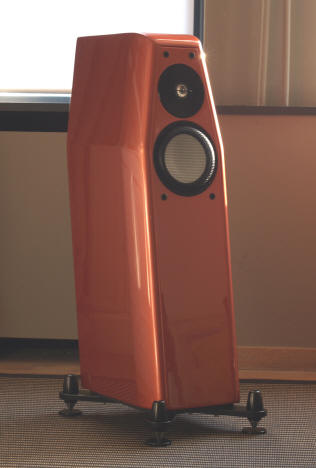
|
MARSHALL NACK'S SYSTEM
LOUDSPEAKERS
ELECTRONICS
SOURCES
CABLES
ACCESSORIES
|
First, the CRM 3.2 FE
Here's how it usually goes. Most people get the best speakers they can afford. Then they spend the next few years coming to terms with their colorations, for all speakers have colorations. In large part your system grows up around the choice of speaker. This is what sets the Kharma CRM 3.2 FE apart. Of course, it has limitations and a character but, as far as I can tell, I don't hear those common colorations. What are these common colorations? Boxy sounding? Doesn't apply here. Romantic? Uh-uh. Wooly or veiled? Nope. Rolled off treble? Definitely not. Crossover-related frequency anomalies? Nope.
Say that number again?
$21,000. "They sure look beautiful, but how much did you say they cost?" $21,000. Right. The CRM 3.2 FE may well be the most expensive two-way speaker on the planet. So, aside from bragging rights, what you get for that sum? Answer: the all-out assault by one of the world's foremost speaker designers to create the best two-way system available today.
Yes, they look beautiful; they should. The cabinets are assembled in Holland, shipped to Italy for finishing and then returned to Holland. What you don't see is that those cabinets are CNC machined out of High Density Fiberboard instead of the more common MDF and the entire interior is treated with a expensive, proprietary anti-vibration polymer. Some of the goodies lurking inside include pure silver coils in the crossover along with top-of-the-line Kharma Enigma internal wiring (this gives it the E in the FE model designation, as in Focal Enigma, which is standard on all 3.2s sold in the USA.) Coils and wires are assembled, cryogenically treated, and a layer of that anti-vibe polymer is applied. The driver complement is a 7-inch midrange sourced from Thiel and Partner (known as Accuton in the USA) and a Focal 25 mm inverted dome Titanium tweeter, both of which receive further tweaking after they arrive at the Kharma factory. Jonathan Valin called this "…ceramic mid/woof the best dynamic midrange…" he's heard (TAS 140). He lavished similar praise on the Focal tweeter. Then there's the SDSS stands made from aircraft-quality aluminum with their cross brace and heavy-duty spike feet, which look like they're up to military spec, and finally the top-line WBT OFC binding posts. The whole assemblage is scrutinized to insure zero susceptibility to resonances (note that this is accomplished without mass damping—each speaker weighs in at 70 lbs.) So you see, getting the best parts is only the beginning—everything is subjected to mods at the Kharma factory. The fixation on quality is relentless.
Now you have an idea of the extent of this assault at the pinnacle. You can see the lack of coloration is no coincidence. OK, so what do they sound like?
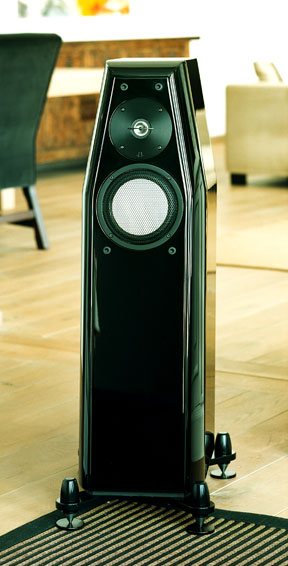
You want clarity?
After living with the 3.2s for over a year, I would say what comes to mind first after their lack of coloration is their single voice. People have said many things regarding the 3.2s, but an audible crossover has not been one of them. The two drivers working together truly speak as one, a source that virtually disappears into an expansive soundstage. Um, on second thought, maybe that's what should be mentioned first: the proportions of the stage they throw are not at all what you'd expect from a three-foot tall compact speaker. Then again, if you're accustomed to speakers with dynamic cone drivers, you're sure to remark upon the 3.2s uncommon clarity, accuracy and purity. And speed—fuggeddaboudit! The drivers in their cabinet exhibit witheringly low overhang and recover with lightening speed. The 3.2 response encroaches on electrostatic territory—you'd be very hard pressed to come up with a faster dynamic speaker. Maybe it's that 7-inch ceramic mid/woof—I noticed similar speed with the Ayon Signature speakers, which also have a 7-inch Accuton midrange (same manufacturer, but different model).
Also to be considered is their resolving power, which is as good as it gets. Image quality? Imaging is of a different sort. Pinpoint imaging freaks won't find nirvana here. You'll find it looser, larger, more of a 3D sort, with soft borders. Very few images reside in the cabinets, depending on the source, of course. I'm sure Kharma's attention to controlling resonances helps the speaker perform this disappearing act. One interesting sidebar, while we're on staging: have you ever noticed how most speakers which are capable of floating images outside the box manage quite well in their mid and upper frequencies, but can't seem to get the bass out of the cabinet? No problem here.
OK. The highest quality parts are assembled in an innovative and well-designed cabinet. Expense was not a consideration. Now then, after enumerating these wonderful qualities, I'm sure you're wondering if I'm gonna drop some caveats, just to balance things out. Yes, there are a few things to mention.
Some people may find their purity a little on the dry side. The feel of the 3.2 is a kind of dry warmth, not cool, but not wet. Some people may find them too energetic on top. Yeah, that's possible. This will depend greatly on your associated components. Keep in mind they were voiced with the Lamm ML2 mono-block amplifiers—they do like the characteristic Single Ended Triode treble and rich body. Also mind their very high, built-in resolution. Unlike other speakers, you won't have to work to get resolution—it comes with the package. More than likely, you'll be taking out many tried and true tweaks—they'll be overkill with the 3.2s. Lastly, if you must have the bottom octave and a half, you were out of luck—until now, with the advent of the Kharma Ce-Sb sub.
How to get magic
The stellar combination of the solid state YBA Passion 1000 mono-blocks and my reference Eggleston Works Rosa speakers was not repeated with the 3.2s. The YBAs strengths—they are super fast, clean and throw hugely powerful transients—which worked so well with the Rosas, coincided with some of the Kharma's. The result was a dry, lean and mean machine. The darTZeel NHB-108, with its more tube-like character, was a better mate in the SS amp category. This combo caught peoples' attention.
But it was with the 40-watt Mastersound 845 SET tube mono-blocks that we found ourselves in "drop dead gorgeous" terrain. Now we had speed, dynamics and definition with weight, body and the inner life for which SET amps are known. The Mastersound added flesh and richness to the entire sonic picture, shifted energy away from the treble and rounded it. Most importantly, a human element was thrown into the mix. The music began to breathe—an alluring, if not ruler accurate, sound. This was the kind of sound that stops people in their tracks.
Then there was the Lamm ML1.1, push-pull, 90-watt monos. Now we had a damned fine facsimile of "it," that auditory sensation we experience 24/7. There were aspects to this presentation that broadened my knowledge of what is possible in reproduced sound. This was the most accurate, most realistic sound I've gotten.
Most recently it's been the Reimyo PAT-777 8-watt 300B stereo amp driving the 3.2s. No doubt you're thinking, "This can't work, it's way under-powered. He's going off again," right? Everyone thought so, including me, and all our assumptions were confounded. The "puny" PAT-777 drove the 3.2s to new realms of beauty. And, by golly, it was as dynamic, if not more so, than with my 100-watt von Gaylord Nirvana push-pull monos! This was a great match and gave up nothing, except some neutrality. If the idea of SET emotion mated with clarity and precision appeals, do consider this combo.
What an easy load to drive! The 3.2s present a flat 8 ohms. Each amp's personality was nakedly revealed.
Speaker setup
This happy state of affairs occurred only after I reverse engineered many tried and true assumptions. My system grew up around the Eggleston Works Rosas, which sing in an entirely different voice. For one thing, AC conditioning had to be mostly eliminated with the 3.2s. They let you hear how it dulled transients and pace, and made the sound less complex. I came to realize that metal in contact with metal usually was a source of brightness, so out went all the metal cones and spike footers. This included the metal discs under the SDSS aluminum spikes, another metal-to-metal intersection. By the way, a great replacement for the SDSS metal discs are the Harmonix RF-900 spike bases, or the more potent Harmonix RF-999MT. Either of these will give you a warmer, weightier sound. While we're on tweaks, to get even more warmth and weight, try the Harmonix RF-57 Mk II Tuning Bases on the front corners of the speaker baffle, forming a rectangle just outside the drivers. Adjusting speaker height via the spikes can also effect small changes in the tonal balance—the closer to the floor the darker the palette.
The Kharma 3.2s engage the room unlike any speaker I've ever had. I started with the 3.2s in the same position as my reference Rosas; that is, one third of the way in, close to the side walls and toed-in to face the listener. Bill Parish, the USA Kharma importer, came over one day with a frequency spectrum analyzer so we could see what was what. The in-room analysis revealed suckouts at 200 and 160Hz in both channels. We thought this might be room related. Indeed, the Rosas in the same placement had a 200Hz suckout in the right channel. Then Bill moved the 3.2s to the Kharma recommended position, the same distance from the rear wall, about 28 inches from the sides, with about 7 feet between the tweeters, and no toe-in.
Lo and behold, the suckouts disappeared. Unbelievably, the low end measured stronger. The 3.2s in the recommended position were linear to 35Hz as specified, with decent readings down to 25Hz. This ain't what you'll read in textbooks about the importance of reinforcing side or rear walls for stronger bass response, but these are the empirical facts. Go figure. Understand this, however: even though there was measured energy, I stopped hearing anything appreciable below about 50Hz.
Part II: Developments down under
The 3.2s with any of the tube amps were easily a Class A presentation—very satisfying, centered in the mid-range, with great extension and linearity from the top on down to the mid-bass. I preferred the SET amps, the Master Sound 845 or the Reimyo PAT-777, for their added body and soul and stopped here for a while but, being a card-carrying audiophile, I decided I needed the whole shebang. To truly have a no-compromise, no-excuses sound you must have that lowest octave and a half. That is why I acquired a Talon ROC sub-woofer. For the ultimate enjoyment of full orchestra or other music employing large forces, you will need a sub.
One day, I turned off the ROC… and was taken aback at how much coherency, speed and articulation I had been sacrificing. The bass was dragging the beat, and this in turn muddied up everything. The low frequencies were comparatively loose, and caused distortion and blurring of the image's shape. The Talon sub simply could not keep up with the main speakers. This is the same problem as when mating a sub with Quad electrostats or Magnepan planars. Mind you the Talon ROC is a high-quality sub.
Then, at Bill's urging, we physically removed the sub because it was taking up a lot of real estate between the speakers. Yikes! This had the effect of filling in the holes in the stage width and giving instruments more body. The 3.2s want to work together in the room—avoid large obstructions in the area between them. Nevertheless, the ROC went back in, compromises not withstanding, because I wanted a full-range sound.
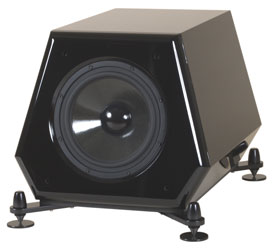 Finally speed enough to match the 3.2s
Finally speed enough to match the 3.2s
It was at this point the Kharma Ce-Sb-1.0 sub-woofer arrived and it was love at first sound bite: I christened it "My Little Dachshund." The immediate experience after you pushed the play button on the remote was an enhanced sense of the volume of the venue, especially on live recordings, like Schubert Lieder (DG B0000049-02). The various orchestral sections make their entrances, populating the virtual stage. Low-level, low-frequency cues fill in the hall's dimensions. This was happening because the sub's response time was finally a match to the 3.2s. That last sought-after frequency coherency was in place, now that the low-end had matching quickness and agility. The crispness, the clarity, the new power of transients… all coalesced into a SOTA level of full-range transparency.
 Unbelievably, the Ce-Sb does for low-end resolution
what the 3.2s do for the mids and treble. Take the thunderclaps at the start of
track 11 from Handel's Rinaldo (Harmonia Mundi HMC 901796.98). Conductor Renée
Jacobs has been on a roll lately, with a spate of excellent releases. This one
from 2003 is as good as the best of them. Uh-oh. You hear the mallet hit the
skin of the bass drum, then the principal bass note thunders, followed by
receding waves of resonance. Those low frequency waves following the principal
note arrive pulsing with changing SPLs and exude definition and energy—the sub
is responding to the millisecond variations in the signal and giving the waves
texture. Ah, this is something I haven't heard before.
Unbelievably, the Ce-Sb does for low-end resolution
what the 3.2s do for the mids and treble. Take the thunderclaps at the start of
track 11 from Handel's Rinaldo (Harmonia Mundi HMC 901796.98). Conductor Renée
Jacobs has been on a roll lately, with a spate of excellent releases. This one
from 2003 is as good as the best of them. Uh-oh. You hear the mallet hit the
skin of the bass drum, then the principal bass note thunders, followed by
receding waves of resonance. Those low frequency waves following the principal
note arrive pulsing with changing SPLs and exude definition and energy—the sub
is responding to the millisecond variations in the signal and giving the waves
texture. Ah, this is something I haven't heard before.
Have you ever heard a sub with an overtone complement? Most have little true musical content, not to mention their overhang issues and the lack of texture. I'm used to hearing a smooth, dark noise here. The Ce-Sb is the first I've encountered that makes music. These qualities, speed, definition and overtone complement, are probably what make it so hard to localize as a point source. Even at loud levels, its sound simply meshes with the main drivers.
On occasion, I turned off the sub to check out the 3.2s voicing. The Ce-Sb comes real close, much closer than the ROC, but the coherency, the seamlessness of the 3.2s alone is still unmatched. If you can live with the 3.2s LF limitation, you'll be hard pressed to find better.
I have to confess—I've never given the low frequencies their due. Bass has always been the lowest of my priorities. Treble was often in first position, making sure extension wasn't compromised, and more recently, striving for its integration with other bands. Ah, but you see, when the bass is correct, many things fall into place. Your subliminal reservations subside, you relax, nay, you wallow that much more deeply in the facsimile before you. When the sub frees the low-end, or I should say, when the low-end matches the rest of the spectrum, you're looking at new benchmarks for realism and involvement.
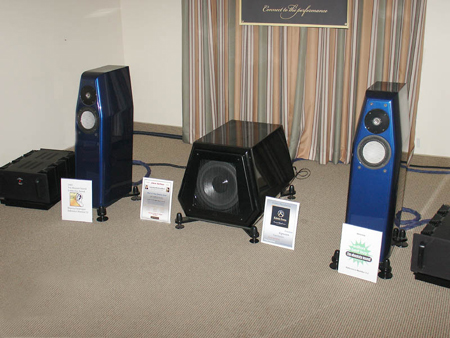
Break-in
The Ce-Sb was put in the same spot as the Talon ROC, approximately centered between the 3.2s, its driver and those of the 3.2 aligned in the same horizontal plane, so their sound waves would arrive together. I simply removed the wires from the ROC and inserted them into the Ce-Sb. The first evening was spent twiddling with the remote and the John Rutter Requiem (Reference Recordings RR-57CD), tweaking the various setup parameters. The Requiem is a perfect choice for sub setup, with its prominent, massive organ pedal notes. Remote access to the sub's slope and output levels made it a cinch to adjust sound quality. Try to set the sub's LPF (low frequency cutoff) below 80Hz because above that it becomes audible. In this configuration, the main speakers are left to run full-range, which is arguably the best way to incorporate a sub. The Ce-Sb was optimized for my reference system with the LPF at 60 and Output level at -8dB.
Day one, the sub sounded dark, the bass was noticeable, but still more musical than any sub-woof I've encountered. Day two, with about fifteen hours play time, the darkness lifted and the speed of the little Dachshund was in sync with the 3.2s drivers. Coherence was amazing. The sound actually got a bit drier as it tightened up. Give the Ce-Sb a couple of days play time with the cutoff frequency set to its max (200Hz) to loosen its 12-inch driver and properly break-in.
You might guess interconnects make a difference. How about power cords? I generally used a Golden Sound Red power cord and Harmonic Tech Magic interconnects. I didn't think the PC would matter, so one day I swapped to a lower-grade one just because it was flexible and more user friendly. Then, for a week or two I had a bad case of the yawns—the sound was no longer engaging. On a lark, I put the GS Red back in and, voila, ‘twas made whole again. The GS Red brought its characteristic bloom and richness and this unexpectedly influenced the mid range so the entire spectrum was more open and rich. Especially with the Ce-Sb, which is capable of playing musical overtones, you want quality wires. For heaven's sake, don't skimp on the PC or interconnects.
The Ce-Sb was designed to pair with the CRM 3.2 FE speakers. Visually and sonically, they exactly complement each other. It's easy to imagine the Ce-Sb mating perfectly with any Kharma model but would the Ce-Sb mate as well with other brands? The issue with subs is usually their relative slowness compared to the main drivers. In the case of the Ce-Sb, I don't think you'll need to worry on that score, but you may find the opposite, where the sub is actually faster and tighter than the main speakers' bass. Can you imagine the subs output arriving a little early and departing a little ahead of the rest? I did and it's true: I mated the Ce-Sb with a lush sounding full-range speaker and the bass did get tighter and punchier.
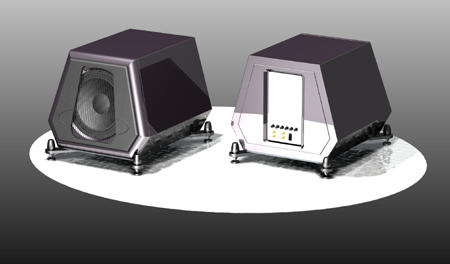
Fit & Finish
From a décor perspective, the Kharma system actually got positive WAF (Wife Acceptance Factor). The appearance and finish are impeccable. Even my mom-in-law, a classy lady who might come to visit with white gloves in her purse, didn't object. Which all surprised me, because the Ce-Sb-1.0 is a large, physically massive, unavoidable object in a central location.
The front-firing 12-inch driver is powered by a 400-watt Kharma Manufactured Proprietary Pulse Width Modulation amp, and is ported towards the floor. Both amp and driver are custom made to Kharma's spec. You get gold-plated WBT RCA and Neutrik balanced inputs to be connected from a second set of pre-amp outputs. The SDSS stand is included. The chassis of both CRM 3.2 and Ce-Sb are well damped without applying a lot of mass—the 3.2s are only 70 lbs, while the Ce-Sb comes in at 90. A knuckle rap on any surface did nothing more than return a dull thud. The grill consists of elastic strings stretched vertically in front of the woofer diaphragm, which is exposed behind it. Quite impressive looking, too—it makes the 3.2s seem diminutive.
The sub has a dedicated remote that attaches via a phone cord. You bring the remote with you to the listening seat to make adjustments to the various (and plentiful) controls, including some DSP parameters.
Conclusion
The unanimous reaction to the Kharma CRM 3.2 FE was that they have superb fit and finish, immediately followed by "How much did you say they cost?" People expect to see more for that kind of money. Indeed, the compact 3.2 is probably the most expensive two-way speaker on the market. Yes, you can easily get a more imposing-looking speaker for less money. In fact, Kharma makes two bigger 3-way models, the Ce 2.2 and Ce 1.1, sporting 9- and 11-inch woofers respectively, that sell for less. Which brings home the fact that there's more to the 3.2 than meets the eye. A lot more.
At this level of playback, you better make sure your associated equipment is up to the challenge, because the 3.2s are transparent to the source. You won't have to worry about any of the common colorations—or definition, clarity or coherency. You will probably be removing lots of tried and true tweaks, as you won't need to augment what is already provided. The 3.2s do have a preference for SET tube amps.
The CRM 3.2 FE achieves perfection in what it is designed to do, barring its low-frequency limitations. While I still think most audiophiles' fixation on bass is misplaced, I now see that the lows can't be dismissed. That's where a subwoofer comes in, and the Ce-Sb-1.0 is the only one I know that's fast enough to keep up with the 3.2s. Marry the two and you're looking at a world-class transducer system. Adding the Ce-Sb-1.0 provides the missing link to turn the tumblers, which lets us pass through the doorway. Together, they give us access to a no-compromise, no-excuses-required level of presentation.
Specifications: CRM 3.2 FE
-
Type: Two-way floor-standing dynamic loudspeaker
-
Drivers: 1.5" inverted-dome titanium tweeter, 7" concave ceramic mid-bass
-
Power Handling: 100 watts
-
Frequency Response: 35Hz - 25kHz, -3dB
-
Crossover: 1.75kHz
-
Sensitivity: 89 dB (1W/1m)
-
Impedance: 8 ohms
-
Dimensions: 36" h x 16" d x 12" w
-
Weight: 70 pounds
-
Price: $21,000
Specifications: Ce-Sb-1.0
-
Type: Forward firing, ported sub-woofer
-
Drivers: one 12" dynamic
-
Amplifier: 400 watt digital
-
Frequency Response: 15Hz - 200Hz
-
Dimensions: 21" h x 27" d x 21" w
-
Weight: 90 pounds
-
Price: $9500
Manufacturer
O.L.S. Audiotechnology
The Netherlands
web address:
www.kharma.com
Distributor Information
GTT Audio/Video
356 Naughright Rd.
Long Valley, New Jersey 07853
TEL: 908. 850. 3092
email address: [email protected]
webs address:
www.gttgroup.com
